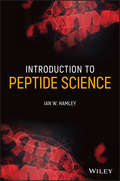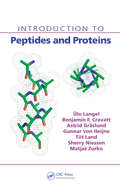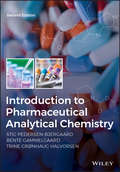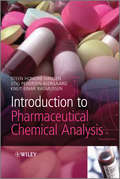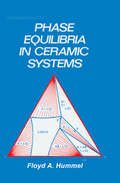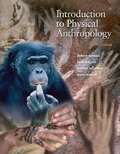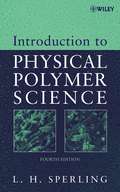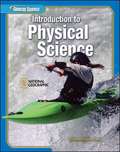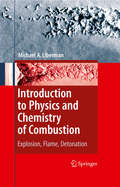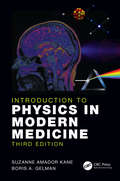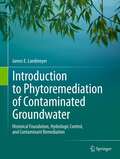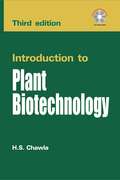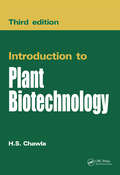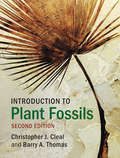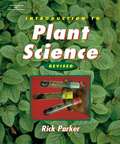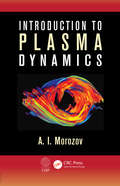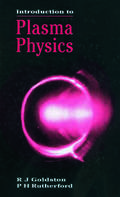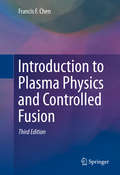- Table View
- List View
Introduction to Peptide Science
by Ian W. HamleyProvides an interdisciplinary introduction to peptide science, covering their properties and synthesis, as well as many contemporary applications Peptides are biomolecules comprised of amino acids which play an important role in modulating many physiological processes in our body. This book presents an interdisciplinary approach and general introduction to peptide science, covering contemporary topics including their applicability in therapeutics, peptide hormones, amyloid structures, self-assembled structures, hydrogels, and peptide conjugates including lipopeptides and polymer-peptide conjugates. In addition, it discusses basic properties and synthesis clearly and concisely. Taking a logical approach to the subject, Introduction to Peptide Science gives readers the fundamental knowledge that is required to understand the cutting-edge material which comes later in the book. It offers readers in-depth chapter coverage of the basic properties of peptides; synthesis; amyloid and peptide aggregate structures; antimicrobial peptides and cell-penetrating peptides; and peptide therapeutics and peptide hormones. Introduces readers to peptide science, including synthesis and properties Provides unique content covering properties, synthesis, self-assembly, aggregation, and applications Summarizes contemporary topics in an accessible fashion including applications in therapeutics, peptide hormones, amyloid structures, self-assembled structures, hydrogels, and peptide conjugates including lipopeptides Presented at an introductory level for the benefit of students and researchers who are new to the subject Introduction to Peptide Science is an ideal text for undergraduate students of chemistry, biochemistry, and other related biological subjects, and will be a valuable resource for postgraduate students and researchers involved in peptide science and its applications.
Introduction to Peptides and Proteins
by Ulo Langel Benjamin F. Cravatt Astrid Graslund N.G.H. von Heijne Matjaz Zorko Tiit Land Sherry NiessenHuman cells produce at least 30,000 different proteins. Each has a specific function characterized by a unique sequence and native conformation that allows it to perform that function. While research in this post-genomic era has created a deluge of invaluable information, the field has lacked for an authoritative introductory text needed to inform
Introduction to Perturbation Theory in Quantum Mechanics
by Francisco M. FernandezPerturbation theory is a powerful tool for solving a wide variety of problems in applied mathematics, a tool particularly useful in quantum mechanics and chemistry. Although most books on these subjects include a section offering an overview of perturbation theory, few, if any, take a practical approach that addresses its actual implementation
Introduction to Petroleum Engineering
by John R. Fanchi Richard L. ChristiansenPresents key concepts and terminology for a multidisciplinary range of topics in petroleum engineering Places oil and gas production in the global energy context Introduces all of the key concepts that are needed to understand oil and gas production from exploration through abandonment Reviews fundamental terminology and concepts from geology, geophysics, petrophysics, drilling, production and reservoir engineering Includes many worked practical examples within each chapter and exercises at the end of each chapter highlight and reinforce material in the chapter Includes a solutions manual for academic adopters
Introduction to Pharmaceutical Analytical Chemistry
by Stig Pedersen-Bjergaard Bente Gammelgaard Trine G. HalvorsenThe definitive textbook on the chemical analysis of pharmaceutical drugs – fully revised and updated Introduction to Pharmaceutical Analytical Chemistry enables students to gain fundamental knowledge of the vital concepts, techniques and applications of the chemical analysis of pharmaceutical ingredients, final pharmaceutical products and drug substances in biological fluids. A unique emphasis on pharmaceutical laboratory practices, such as sample preparation and separation techniques, provides an efficient and practical educational framework for undergraduate studies in areas such as pharmaceutical sciences, analytical chemistry and forensic analysis. Suitable for foundational courses, this essential undergraduate text introduces the common analytical methods used in quantitative and qualitative chemical analysis of pharmaceuticals. This extensively revised second edition includes a new chapter on chemical analysis of biopharmaceuticals, which includes discussions on identification, purity testing and assay of peptide and protein-based formulations. Also new to this edition are improved colour illustrations and tables, a streamlined chapter structure and text revised for increased clarity and comprehension. Introduces the fundamental concepts of pharmaceutical analytical chemistry and statistics Presents a systematic investigation of pharmaceutical applications absent from other textbooks on the subject Examines various analytical techniques commonly used in pharmaceutical laboratories Provides practice problems, up-to-date practical examples and detailed illustrations Includes updated content aligned with the current European and United States Pharmacopeia regulations and guidelines Covering the analytical techniques and concepts necessary for pharmaceutical analytical chemistry, Introduction to Pharmaceutical Analytical Chemistry is ideally suited for students of chemical and pharmaceutical sciences as well as analytical chemists transitioning into the field of pharmaceutical analytical chemistry.
Introduction to Pharmaceutical Chemical Analysis
by Knut Rasmussen Steen Hansen Stig Pedersen-BjergaardThis textbook is the first to present a systematic introduction to chemical analysis of pharmaceutical raw materials, finished pharmaceutical products, and of drugs in biological fluids, which are carried out in pharmaceutical laboratories worldwide.In addition, this textbook teaches the fundamentals of all the major analytical techniques used in the pharmaceutical laboratory, and teaches the international pharmacopoeias and guidelines of importance for the field. It is primarily intended for the pharmacy student, to teach the requirements in "analytical chemistry" for the 5 years pharmacy curriculum, but the textbook is also intended for analytical chemists moving into the field of pharmaceutical analysis.Addresses the basic concepts, then establishes the foundations for the common analytical methods that are currently used in the quantitative and qualitative chemical analysis of pharmaceutical drugsProvides an understanding of common analytical techniques used in all areas of pharmaceutical developmentSuitable for a foundation course in chemical and pharmaceutical sciencesAimed at undergraduate students of degrees in Pharmaceutical Science/Chemistry Analytical Science/Chemistry, Forensic analysisIncludes many illustrative examples
Introduction to Phase Equilibria in Ceramic Systems
by HummelWritten by a leading practitioner and teacher in the field of ceramic science and engineering, this outstanding text provides advanced undergraduate- and graduate-level students with a comprehensive, up-to-date Introduction to Phase Equilibria in Ceramic Systems. Building upon a concise definition of the phase rule, the book logically proceeds from one- and two-component systems through increasingly complex systems, enabling students to utilize the phase rule in real applications. Unique because of its emphasis on phase diagrams, timely because of the rising importance of ceramic applications, practical because of its pedagogical approach, Introduction to Phase Equilibria in Ceramic Systems offers end-of-chapter review problems, extensive reading lists, a solid thermodynamic foundation and clear perspectives on the special properties of ceramics as compared to metals.This authoritative volume fills a broad gap in the literature, helping undergraduate- and graduate-level students of ceramic engineering and materials science to approach this demanding subject in a rational, confident fashion. In addition, Introduction to Phase Equilibria in Ceramic Systems serves as a valuable supplement to undergraduate-level metallurgy programs.
Introduction to Photocatalysis: Fundamentals and Applications
by Tahir Iqbal Awan Sumera Afsheen Iqra MaryamExplore the intriguing world of photocatalysis with Introduction to Photocatalysis: Fundamentals and Applications. This book explores the complexities of photocatalytic processes, investigating the contributing elements, nano-photocatalyst manufacturing methodologies, and their wide applications in the energy and environmental sectors.Additionally, sophisticated modification approaches that may be used to improve the efficiency of visible light-driven processes (such as doping and plasmonics photocatalysis) are discussed. Key features include novel methodologies of photocatalysts, providing an insight on fundamentals and methodology; and examples of efficient applications of photocatalysis such as wastewater treatment, hydrogen production and CO2 reduction. Later chapters discuss the commercial aspects of photocatalysis to help guide future entrepreneurs.The book is useful for advanced undergraduates, and graduate students in a range of subjects such as physics, biotechnology, and biochemistry. This book will also prove invaluable for researchers and scientists in photocatalysis, and chemical engineers and chemists in industry R&D working on wastewater treatment and renewable sources of energy. It stands out as a modernized version of current literature that bridges the gap between scholars and students.
Introduction to Photoelectron Angular Distributions: Theory and Applications (Springer Tracts in Modern Physics #286)
by V. T. DavisThis book provides a comprehensive introduction to photoelectron angular distributions and their use in the laboratory to study light-matter interactions. Photoelectron angular distribution measurements are useful because they can shed light on atomic and molecular electronic configurations and system dynamics, as well as provide information about quantum transition amplitudes and relative phases that are not obtainable from other types of measurements. For example, recent measurements of molecular-frame photoelectron angular distributions have been used to extract photoelectron emission delays in the attosecond range which can provide ultra-sensitive maps of molecular potentials. Additionally, photoelectron angular distribution measurements are an essential tool for studying negative ions. Here, the author presents a detailed, yet easily accessible, theoretical background necessary for experimentalists performing photoelectron angular distribution measurements to better understand their results. The various physical influences on photoelectron angular distributions are revealed through analytical models with the use of angular momentum coupling algebra and spherical tensor operators. The classical and quantum treatments of photoelectron angular distributions are covered clearly and systematically, and the book includes, as well, a chapter on relativistic interactions. Furthermore, the primary methods used to measure photoelectron angular distributions in the laboratory, such as photodetachment electron spectroscopy, velocity-map imaging, and cold target recoil ion momentum spectroscopy, are described. This book features introductory material as well as new insights on the topic, such as the use of angular momentum transfer theory to understand the process of photoelectron detachment in atoms and molecules. Including key derivations, worked examples, and additional exercises for readers to try on their own, this book serves as both a critical guide for young researchers entering the field and as a useful reference for experienced practitioners.
Introduction to Physical Anthropology (9th Edition)
by Robert JurmainThe textbook explains the subject's basic principles and examines the place of the human species in the biological world. It begins with a broad overview of heredity and evolution, then focuses the discussion on primates, hominids, and finally, contemporary human evolution. The authors are affiliated with San Jose State University, Colorado State University, and New Mexico State University. Annotation ©2004 Book News, Inc., Portland, OR (booknews.com)
Introduction to Physical Education, Exercise Science, and Sport
by Angela LumpkinIntroduction to Physical Education, Exercise Science, and Sport explores the exciting diversity of physical education, exercise science, and sport, and examines the breadth of potential careers available in these multifaceted fields. Students are introduced to the heritage, current programs, and future potential of these rapidly expanding areas. The text delves into practical suggestions, including how to create resumes and how to help students prepare for careers in physical education and exercise science in diverse settings. Written in a conversational and personal style, the text is designed for students enrolled in their first course related to the field.
Introduction to Physical Polymer Science
by L. H. SperlingAn Updated Edition of the Classic Text Polymers constitute the basis for the plastics, rubber, adhesives, fiber, and coating industries. The Fourth Edition of Introduction to Physical Polymer Science acknowledges the industrial success of polymers and the advancements made in the field while continuing to deliver the comprehensive introduction to polymer science that made its predecessors classic texts. The Fourth Edition continues its coverage of amorphous and crystalline materials, glass transitions, rubber elasticity, and mechanical behavior, and offers updated discussions of polymer blends, composites, and interfaces, as well as such basics as molecular weight determination. Thus, interrelationships among molecular structure, morphology, and mechanical behavior of polymers continue to provide much of the value of the book. Newly introduced topics include: * Nanocomposites, including carbon nanotubes and exfoliated montmorillonite clays * The structure, motions, and functions of DNA and proteins, as well as the interfaces of polymeric biomaterials with living organisms * The glass transition behavior of nano-thin plastic films In addition, new sections have been included on fire retardancy, friction and wear, optical tweezers, and more. Introduction to Physical Polymer Science, Fourth Edition provides both an essential introduction to the field as well as an entry point to the latest research and developments in polymer science and engineering, making it an indispensable text for chemistry, chemical engineering, materials science and engineering, and polymer science and engineering students and professionals.
Introduction to Physical Science
by McGraw-HillProvides students with accurate and comprehensive content coverage of the three fundamental science disciplines. The concepts covered are explained in a clear, concise manner that can be easily understood. This strong content coverage integrates a wide range of hands-on experiences, critical-thinking opportunities, real-world applications, and connections to other sciences and non-science areas of the curriculum.
Introduction to Physical Science
by McGraw-HillA book helping students to understand concepts of physical science.
Introduction to Physics and Chemistry of Combustion
by Michael A. LibermanMost of the material covered in this book deals with the fundamentals of chemistry and physics of key processes and fundamental mechanisms for various combustion and combustion related phenomena in gaseous combustible mixture. It provides the reader with basic knowledge of burning processes and mechanisms of reaction wave propagation. The combustion of a gas mixture (flame, explosion, detonation) is necessarily accompanied by motion of the gas. The process of combustion is therefore not only a chemical phenomenon but also one of gas dynamics. The material selection focuses on the gas phase and with premixed gas combustion. Premixed gas combustion is of practical importance in engines, modern gas turbine and explosions, where the fuel and air are essentially premixed, and combustion occurs by the propagation of a front separating unburned mixture from fully burned mixture. Since premixed combustion is the most fundamental and potential for practical applications, the emphasis in the present work is be placed on regimes of premixed combustion. This text is intended for graduate students of different specialties, including physics, chemistry, mechanical engineering, computer science, mathematics and astrophysics.
Introduction to Physics in Modern Medicine
by Suzanne Amador Kane Boris A. GelmanFrom x-rays to lasers to magnetic resonance imaging, developments in basic physics research have been transformed into medical technologies for imaging, surgery and therapy at an ever-accelerating pace. Physics has joined with genetics and molecular biology to define much of what is modern in modern medicine and allied health. Covering a wide range of applications, Introduction to Physics in Modern Medicine, Third Edition builds further on the bestselling second edition. Based on the courses taught by the authors, the book provides medical personnel and students with an exploration of the physics-related applications found in state-of-the-art medical centers. Requiring no previous acquaintance with physics, biology, or chemistry and keeping mathematics to a minimum, the application-dedicated chapters adhere to simple and self-contained qualitative explanations that make use of examples, illustrations, clinical applications, sample calculations, and exercises. With an enhanced emphasis on digital imaging and computers in medicine, the text gives readers a fundamental understanding of the practical application of each concept and the basic science behind it. This book provides medical students with an excellent introduction to how physics is applied in medicine, while also providing students in physics with an introduction to medical physics. Each chapter includes worked examples and a complete list of problems and questions. That so much of the technology discussed in this book was the stuff of dreams just a few years ago, makes this book as fascinating as it is practical, both for those in medicine as well as those in physics who might one day discover that the project they are working on is the basis for the next great medical application. Features: · Introduces state-of-the-art and emerging medical technologies such as optical coherence tomography, x-ray phase contrast imaging, and ultrasound-mediated drug delivery · Covers hybrid scanners for cancer imaging and the interplay of molecular medicine with MRI, CT and PET in addition to intensity-modulated radiation therapy and new forms of cancer treatments such as proton and heavy-ion therapies · Offers an enhanced emphasis on digital imaging and dosimetry including recent innovations in the pixel-array x-ray detectors, ultrasound matrix transducers and direct-ion storage dosimeters
Introduction to Phytoremediation of Contaminated Groundwater
by James E. LandmeyerThis book provides the reader with the comprehensive view necessary to understand and critically evaluate the design, implementation, and monitoring of phytoremediation at sites characterized by contaminated groundwater. Part I presents the historical foundation of the interaction between plants and groundwater, introduces fundamental groundwater concepts for plant physiologists, and introduces basic plant physiology for hydrogeologists. Part II presents information on how to assess, design, implement, and monitor phytoremediation projects for hydrologic control. Part III presents how plants take up and detoxify a wide range of organic xenobiotics in contaminated groundwater systems, and provides various approaches on how this can be assessed and monitored. Throughout, concepts are emphasized with numerous case studies, illustrations and pertinent literature citations.
Introduction to Planetary Geomorphology
by Ronald GreeleyNearly all major planets and moons in our Solar System have been visited by spacecraft and the data they have returned has revealed the incredible diversity of planetary surfaces. Featuring a wealth of images, this textbook explores the geological evolution of the planets and moons. Introductory chapters discuss how information gathered from spacecraft is used to unravel the geological complexities of our Solar System. Subsequent chapters focus on current understandings of planetary systems. The textbook shows how planetary images and remote sensing data are analyzed through the application of fundamental geological principles. It draws on results from spacecraft sent throughout the Solar System by NASA and other space agencies. Aimed at undergraduate students in planetary geology, geoscience, astronomy and solar system science, it highlights the differences and similarities of the surfaces at a level that can be readily understood by non-specialists.
Introduction to Plant Biotechnology (3/e)
by H S ChawlaThis book has been written to meet the needs of students for biotechnology courses at various levels of undergraduate and graduate studies. This book covers all the important aspects of plant tissue culture viz. nutrition media, micropropagation, organ culture, cell suspension culture, haploid culture, protoplast isolation and fusion, secondary metabolite production, somaclonal variation and cryopreservation. For good understanding of recombinant DNA technology, chapters on genetic material, organization of DNA in the genome and basic techniques involved in recombinant DNA technology have been added. Different aspects on rDNA technology covered gene cloning, isolation of plant genes, transposons and gene tagging, in vitro mutagenesis, PCR, molecular markers and marker assisted selection, gene transfer methods, chloroplast and mitochondrion DNA transformation, genomics and bioinformatics. Genomics covers functional and structural genomics, proteomics, metabolomics, sequencing status of different organisms and DNA chip technology. Application of biotechnology has been discussed as transgenics in crop improvement and impact of recombinant DNA technology mainly in relation to biotech crops.
Introduction to Plant Biotechnology (3/e)
by H S ChawlaThis book has been written to meet the needs of students for biotechnology courses at various levels of undergraduate and graduate studies. This book covers all the important aspects of plant tissue culture viz. nutrition media, micropropagation, organ culture, cell suspension culture, haploid culture, protoplast isolation and fusion, secondary metabolite production, somaclonal variation and cryopreservation. For good understanding of recombinant DNA technology, chapters on genetic material, organization of DNA in the genome and basic techniques involved in recombinant DNA technology have been added. Different aspects on rDNA technology covered gene cloning, isolation of plant genes, transposons and gene tagging, in vitro mutagenesis, PCR, molecular markers and marker assisted selection, gene transfer methods, chloroplast and mitochondrion DNA transformation, genomics and bioinformatics. Genomics covers functional and structural genomics, proteomics, metabolomics, sequencing status of different organisms and DNA chip technology. Application of biotechnology has been discussed as transgenics in crop improvement and impact of recombinant DNA technology mainly in relation to biotech crops.
Introduction to Plant Fossils
by Christopher J. Cleal Barry A. ThomasPlant remains can preserve a critical part of history of life on Earth. While telling the fascinating evolutionary story of plants and vegetation across the last 500 million years, this book also crucially offers non-specialists a practical guide to studying, dealing with and interpreting plant fossils. It shows how various techniques can be used to reveal the secrets of plant fossils and how to identify common types, such as compressions and impressions. Incorporating the concepts of evolutionary floras, this second edition includes revised data on all main plant groups, the latest approaches to naming plant fossils using fossil-taxa and techniques such as tomography. With extensive illustrations of plant fossils and living plants, the book encourages readers to think of fossils as once-living organisms. It is written for students on introductory or intermediate courses in palaeobotany, palaeontology, plant evolutionary biology and plant science, and for amateurs interested in studying plant fossils.
Introduction to Plant Science (Revised edition)
by Rick ParkerThis revised text provides a comprehensive introduction to the fascinating world of plant science. From the basic requirements for plant growth, to genetic engineering and biotechnology, this easy- to- understand book is ideal for the high school level agriscience curriculum or college freshman level plant science course. Students will learn about the origins of cultivated plants, structure and anatomy, photosynthesis, respiration, propagation, production of major agronomic crops, and more.
Introduction to Plasma Dynamics
by A. I. MorozovAs the twenty-first century progresses, plasma technology will play an increasing role in our lives, providing new sources of energy, ion-plasma processing of materials, wave electromagnetic radiation sources, space plasma thrusters, and more. Studies of the plasma state of matter not only accelerate technological developments but also improve the
Introduction to Plasma Physics
by R.J GoldstonIntroduction to Plasma Physics is the standard text for an introductory lecture course on plasma physics. The text’s six sections lead readers systematically and comprehensively through the fundamentals of modern plasma physics. Sections on single-particle motion, plasmas as fluids, and collisional processes in plasmas lay the groundwork for a thorough understanding of the subject. The authors take care to place the material in its historical context for a rich understanding of the ideas presented. They also emphasize the importance of medical imaging in radiotherapy, providing a logical link to more advanced works in the area. The text includes problems, tables, and illustrations as well as a thorough index and a complete list of references.
Introduction to Plasma Physics and Controlled Fusion: Volume 1: Plasma Physics
by Francis ChenThis complete introduction to plasma physics and controlled fusion by one of the pioneering scientists in this expanding field offers both a simple and intuitive discussion of the basic concepts of this subject and an insight into the challenging problems of current research. In a wholly lucid manner the work covers single-particle motions, fluid equations for plasmas, wave motions, diffusion and resistivity, Landau damping, plasma instabilities and nonlinear problems. For students, this outstanding text offers a painless introduction to this important field; for teachers, a large collection of problems; and for researchers, a concise review of the fundamentals as well as original treatments of a number of topics never before explained so clearly. This revised edition contains new material on kinetic effects, including Bernstein waves and the plasma dispersion function, and on nonlinear wave equations and solitons. For the third edition, updates was made throughout each existing chapter, and two new chapters were added; Ch 9 on "Special Plasmas" and Ch 10 on Plasma Applications (including Atmospheric Plasmas).
